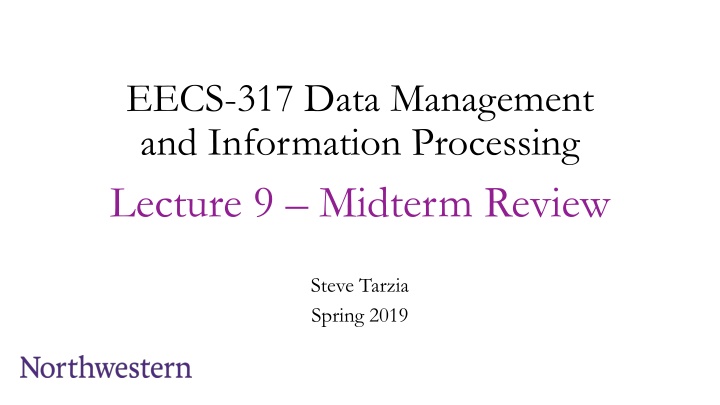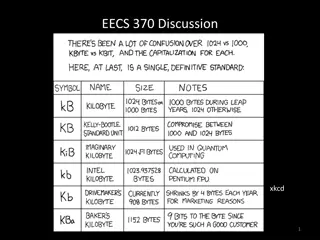
Relational Database Concepts: Schema, Normalization, and Data Modeling
Explore the fundamentals of relational databases, including concepts such as schema design, normalization to reduce redundancy, and creating tables to represent objects, events, and relationships. Learn why relational databases are essential for scalability, data integrity, and efficient querying in data management and information processing.
Download Presentation

Please find below an Image/Link to download the presentation.
The content on the website is provided AS IS for your information and personal use only. It may not be sold, licensed, or shared on other websites without obtaining consent from the author. If you encounter any issues during the download, it is possible that the publisher has removed the file from their server.
You are allowed to download the files provided on this website for personal or commercial use, subject to the condition that they are used lawfully. All files are the property of their respective owners.
The content on the website is provided AS IS for your information and personal use only. It may not be sold, licensed, or shared on other websites without obtaining consent from the author.
E N D
Presentation Transcript
EECS-317 Data Management and Information Processing Lecture 9 Midterm Review Steve Tarzia Spring 2019
Announcements Midterm is next class (Thurs May 2nd) Covers SQL queries. Lectures 1-6 All homeworks Open book, open notes, but you cannot share any materials. Seats will be assigned. Ten page practice exam (with answers) is posted. Last year s midterm (with answers) is also posted. Don t forget to do the practice homeworks in Canvas.
Why use a relational database? Scalability work with data larger than computer s RAM Persistence keep data around after your program finishes Indexing efficiently sort & search along various dimensions Integrity restrict data type, disallow duplicate entries Deduplication save space, keep common data consistent Concurrency multiple users or applications can read/write Security different users can have access to specific data Researchability SQL allows you to concisely express analysis
Sometimes we start with one redundant table and break it down to reflect the logical components staff id 11 20 21 22 35 40 54 name Bob Betsy Fran Frank Sarah Sam Pat department Industrial Eng. Computer Sci. Industrial Eng. Chemistry Physics Materials Sci. Computer Sci. building Tech Ford Tech Tech Mudd Cook Ford room 100 100 101 102 200 10 102 faxNumber 1-1000 1-5003 1-1000 1-1000 1-2005 1-3004 1-5003
This is called Normalization staff department building id name department id name building id name faxNumber 11 Bob 1 1 Industrial Eng. 1 1 Tech 1-1000 20 Betsy 2 2 Computer Sci. 2 2 Ford 1-5003 21 Fran 1 4 Chemistry 1 4 Mudd 1-2005 22 Frank 4 5 Physics 4 5 Cook 1-3004 35 Sarah 5 7 Materials Sci. 5 6 Garage 1-6001 40 Sam 7 Removes redundancy Save space Edit values in one place, so duplicates don t become inconsistent Tables can be populated separately But, you are adding a new id column for each table 54 Pat 2
Tables Represent objects, events, or relationships Each of its rows must be uniquely identifiable Has attributes that the DB will store in columns Can refer to rows in other tables Objects: people, places, or things Events: usually associated with a specific time. Can recur. Relationships: associations Designing a set of tables is called data modelling, and it s best learned by example.
Basic SELECT Syntax table can be: A single table Multiple tables JOINed together A subquery that returns a table
SELECT steps (abbreviated) 1. FROM chooses the table of interest 2. WHERE throws out irrelevant rows 3. GROUP BY identifies rows to combine 4. SELECT tells what values to return (allowing math and aggregation) 5. HAVING throws out irrelevant rows (after aggregation) 6. ORDER BY sorts 7. LIMIT throws out rows based on their position in the results Each step gets closer to the specific result you want.
Integer vs. floating point division Computers store numbers in two basic ways: Integers are whole numbers (0, 3, -40,921) Floating Point numbers (floats) can be fractional (1.234, 0.0, -9.9 10-4) When doing arithmetic on two integers, an integer is always produced. 1+1 = 2, 2-1=1, 4*3=12, 13/4=3 When doing arithmetic involving at least one float, a float is produced. 1.0 + 1.0 = 2.0, 1.5 * 2 = 3.0, 13/4.0=3.25 Integer division is weird it always rounds down: 2/3 = 0, -5/2 = -3 Usually you need floating-point (not integer) division in your queries. Just precede the expression with a floating point operation to force the division to be floating point: 1.0 * -5 / 2 = -2.5
Aggregation functions COUNT, SUM, MIN, MAX, AVG These can be used to print out values that depend on multiple rows. For example, how many ounces of ingredients are used? We have to add up the Amount from many rows to get this answer: SELECT SUM(Amount) FROM Recipe_Ingredients WHERE MeasureAmountID=1; ( ounce corresponds to MeasureAmountID=1) GROUP BY causes aggregations to occur on subsets of rows, where rows are grouped according to some rule. Each group contains rows having the same value for the grouping expression SELECT SUM(Amount) FROM Recipe_Ingredients GROUP BY MeasureAmountID; Same as above, but list amounts of all ingredients
GROUP_CONCAT() is another aggregator Concatenates non-null values, optionally with a separator string. Eg.: Print all the products in each category SELECT CategoryDescription, GROUP_CONCAT(ProductName, ", ") FROM Products NATURAL JOIN Categories GROUP BY CategoryID;
GROUP BY explained GROUP BY combines multiple rows into one row in the result. Rows with the same value for the grouping criterion are grouped. An aggregation function is usually applied. SELECT CategoryID, COUNT(*) AS category_count, MAX(RetailPrice) AS most_expensive_price FROM Products GROUP BY CategoryID;
Subqueries Any single value, list of values, or table can be replaced by a subquery A subquery is a query that appears inside of parentheses. The subquery is computed first and its result is plugged into the parent expression. SELECT SUM(Amount)FROM Recipe_Ingredients WHERE MeasureAmountID= (SELECT MeasureAmountID FROM Measurements WHERE MeasurementDescription="Ounce");
INNER JOIN review In output, multiple matches leads to multiple rows. no matches leads to no rows staff department id name room departmentId id name buildingId 11 Bob 100 1 1 Industrial Eng. 1 20 Betsy 100 2 2 Computer Sci. 2 21 Fran 101 1 4 Chemistry 1 1 Physics 4 SELECT * FROM staff JOIN department ON staff.departmentId=department.id 1 Materials Sci. 5 staff.id 11 11 11 20 21 21 21 staff.name Bob Bob Bob Betsy Fran Fran Fran staff.room 100 100 100 100 101 101 101 staff.departmentId 1 1 1 2 1 1 1 department.id 1 1 1 2 1 1 1 department.name Industrial Eng. Physics Materials Sci. Computer Sci. Industrial Eng. Physics Materials Sci. department.buildingId 1 4 5 2 1 4 5
NATURAL JOIN A shorthand notation to make some JOINs shorter to express. NATURAL JOIN matches rows using whatever columns have identical names. For example: SELECT * FROM Orders JOIN Order_Details ON Orders.OrderNumber=Order_Details.OrderNumber; Becomes: SELECT * FROM Orders NATURAL JOIN Order_Details;
Outer and Cross Joins Introduced different types of JOINs: INNER (default): prints all pairs of rows (one from first table, one from second table) that satisfy the JOIN predicate. LEFT: same as INNER, but adds rows from LEFT table that never satisfied the JOIN predicate. LEFT with exclusion: only print rows from left table that never satisfied the JOIN predicate. CROSS JOIN: print the cartesian project, meaning all rows from the first table combined with all rows from the second table. There is no ON to match rows.
staff department id name room departmentId id name buildingId Betsy and Frank have NULLs in the right haft of the output because no matching department was found. 11 Bob 100 1 1 Industrial Eng. 1 20 Betsy 100 NULL 2 Computer Sci. 2 21 Fran 101 1 5 Physics 4 22 Frank 102 99999 7 Materials Sci. 5 In other words no pair of rows was found to satisfy the ON staff.departmentId=department.id 35 Sarah 200 5 40 Sam 10 7 54 Pat 102 2 SELECT * FROM staff LEFT JOIN department ON staff.departmentId=department.id; staff.id 11 20 21 22 35 40 54 staff.name Bob Betsy Fran Frank Sarah Sam Pat staff.room 100 100 101 102 200 10 102 staff.departmentId 1 NULL 1 99999 5 7 2 department.id 1 NULL 1 NULL 5 7 2 department.name Industrial Eng. NULL Industrial Eng. NULL Physics Materials Sci. Computer Sci. department.buildingId 1 NULL 1 NULL 4 5 2
LEFT JOIN with Grouping When computing an aggregation on a many-to-one relationship, LEFT JOIN includes rows from the parent table with no children. In ClassScheduling.slite, count the classes taught by each faculty member: If you want this report to include faculty members teaching zero classes, you must use LEFT JOIN: SELECT StaffID, ClassID, COUNT(ClassID) AS num_classes FROM Faculty NATURAL LEFT JOIN Faculty_Classes GROUP BY StaffID; Note that COUNT(*) would return 1 for faculty members with no classes, because there would still be one unmatched row from the left table.
UNION, INTERSECT, and EXCEPT are used to combine two SELECT statements UNION printsrowsfrom either of two SELECTs (printing duplicates just once) INTERSECT prints rows present in both SELECTs EXCEPT prints rows present in one SELECT but missing from another SELECT
JOINvs.UNION JOINs combine tables horizontally. Match rows from two tables based on one or more columns matching. Creates a wider set of rows, adding columns from both tables. JOIN: UNION, INTERSECT, and EXCEPT combine result tables vertically Number & type of columns in the two result tables must match Changes the number of rows, not columns UNION:
Summing an indicator variable Two ways to count recipes with salsa in description: SELECT COUNT(*) FROM Recipes WHERE RecipeTitle LIKE "%salsa% ; WHEREclause keeps just the rows matching salsa, then these rows are counted. SELECT SUM(RecipeTitle LIKE "%salsa%") FROM Recipes; A column is created for every recipe indicating whether its title matches salsa or not. Column s value will be 1 if it matches and 0 if not. Sum of all the ones and zeros will be the count of matching recipes. First approach is easier to understand, but second is shorter.
CASE gives if-then-else behavior WHEN condition is tested for every row, giving true or false SELECT CASE WHEN CategoryID=2 THEN "Bike" ELSE ProductName END FROM Products; If condition is true then use the first value. Output: If condition is false then use the second value.
Whats coming in the second half of the course? More data modeling (designing new databases) Indexing to handle large databases Defining databases and adding data Numeric formats integers, floats, precision Dates and times Text encodings ASCII, UTF-8, special characters Organizing data in files (semi-structured data) CSV, XML, JSON Messy data Missing entries, fuzzy matching ... and perhaps more, time permitting
HW3 Q4 SELECT DISTINCT Order_Details.OrderNumber FROM Order_Details NATURAL JOIN Products NATURAL JOIN Product_Vendors JOIN Order_Details AS od2 ON Order_Details.OrderNumber=od2.OrderNumber GROUP BY Order_Details.OrderNumber, VendorID HAVING COUNT(DISTINCT Order_Details.ProductNumber)=COUNT(DISTINCT od2.ProductNumber)
HW3 Q5 EXCEPT -- Start with all orders SELECT OrderNumber FROM Orders -- remove the orders that have three different products available from three different vendors EXCEPT SELECT o1.OrderNumber -- list each possible combination of three line items from each order -- remove the orders that can be satisfied with one vendor (Q4): FROM Order_Details AS o1 JOIN Order_Details AS o2 ON o1.OrderNumber=o2.OrderNumber SELECT DISTINCT Order_Details.OrderNumber JOIN Order_Details AS o3 ON o3.OrderNumber=o1.OrderNumber FROM Order_Details NATURAL JOIN Products NATURAL JOIN Product_Vendors JOIN Product_Vendors v1 ON o1.ProductNumber=v1.ProductNumber JOIN Order_Details AS od2 ON Order_Details.OrderNumber=od2.OrderNumber JOIN Product_Vendors v2 ON o2.ProductNumber=v2.ProductNumber GROUP BY Order_Details.OrderNumber, VendorID JOIN Product_Vendors v3 ON o3.ProductNumber=v3.ProductNumber HAVING COUNT(DISTINCT Order_Details.ProductNumber)=COUNT(DISTINCT od2.ProductNumber) WHERE -- vendors are different v1.VendorID != v2.VendorID AND v1.VendorID != v3.VendorID AND v2.VendorID != v3.VendorID -- products are different AND o1.ProductNumber != o2.ProductNumber AND o1.ProductNumber != o3.ProductNumber AND o2.ProductNumber != o3.ProductNumber;
















